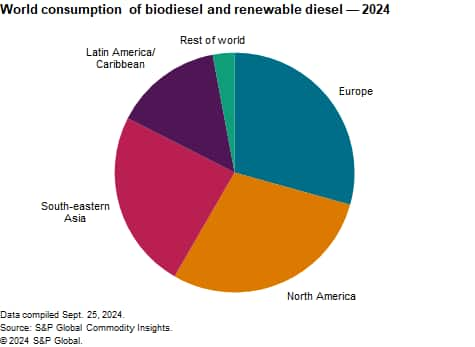Published October 2024
The term biomass-based diesel includes biodiesel (also known as fatty acid methyl esters [FAME]) and renewable diesel (also known as hydrotreated vegetable oil [HVO], hydrogenation-derived renewable diesel [HDRD], hydroprocessed esters and fatty acids [HEFA], or green diesel). Biodiesel and renewable diesel are alike in some respects; both are made from renewable feedstocks and they compete in the same downstream markets. They differ, however, with regard to production processes, chemical composition and physical properties (such as cold flow).
World biodiesel consumption is expected to increase at an average annual rate of 0.2% during 2024–29. South-eastern Asia is the largest market for biodiesel, followed closely by Europe. Future growth will be driven by the expansion of biodiesel markets in South-eastern Asia, Latin America and (to a lesser extent) mainland China. In contrast, demand for biodiesel will shrink in North America, Europe and Japan. Biodiesel production capacity will increase slowly, if at all, in most regions of the world during 2024–29.
World consumption of renewable diesel is predicted to increase at an average annual rate of 9.9% during the forecast period. Consumption of renewable diesel is concentrated in North America and Europe, where the product receives favorable treatment under regulatory policies that emphasize greenhouse gas (GHG) reduction. Renewable diesel has other advantages as well. In contrast to biodiesel, renewable diesel can be blended with conventional diesel at any level without fear of performance issues. During the forecast period, production capacity for renewable diesel will expand substantially, especially in Latin America and the Caribbean, North America and Europe. Greenfield projects (including those that generate renewable diesel as a coproduct of SAF manufacture), retrofits of petroleum refineries and coprocessing of renewable fuels with fossil fuels will all contribute to the capacity expansion.
The following pie chart shows world consumption of biodiesel in 2024:

World consumption of biodiesel and renewable diesel is expected to grow at an average annual rate of 3.0% during 2024–29. Biodiesel is the dominant product; it makes up the lion’s share of consumption in all regions except North America, where demand for renewable diesel significantly exceeds demand for biodiesel. Consumption of renewable diesel is growing at a faster rate than that of biodiesel; as a result, renewable diesel will capture most of the growth in the market.
For more detailed information, see the table of contents, shown below.
S&P Global’s Chemical Economics Handbook – Biodiesel and Renewable Diesel is the comprehensive and trusted guide for anyone seeking information on this industry. This latest report details global and regional information, including

Key benefits
S&P Global’s Chemical Economics Handbook – Biodiesel and Renewable Diesel has been compiled using primary interviews with key suppliers and organizations, and leading representatives from the industry in combination with S&P Global’s unparalleled access to upstream and downstream market intelligence, expert insights into industry dynamics, trade and economics.
This report can help you:
- Identify trends and driving forces influencing biofuel markets
- Forecast and plan for future demand
- Understand the impact of competing materials
- Identify and evaluate potential customers and competitors
- Evaluate producers
- Track changing prices and trade movements
- Analyze the impact of feedstock, regulations and other factors on biofuel profitability


















